Understanding Diamond Clarity: Insights on I2 Grade
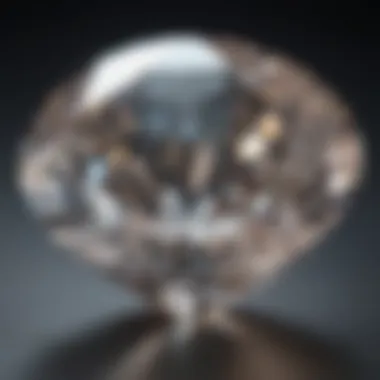
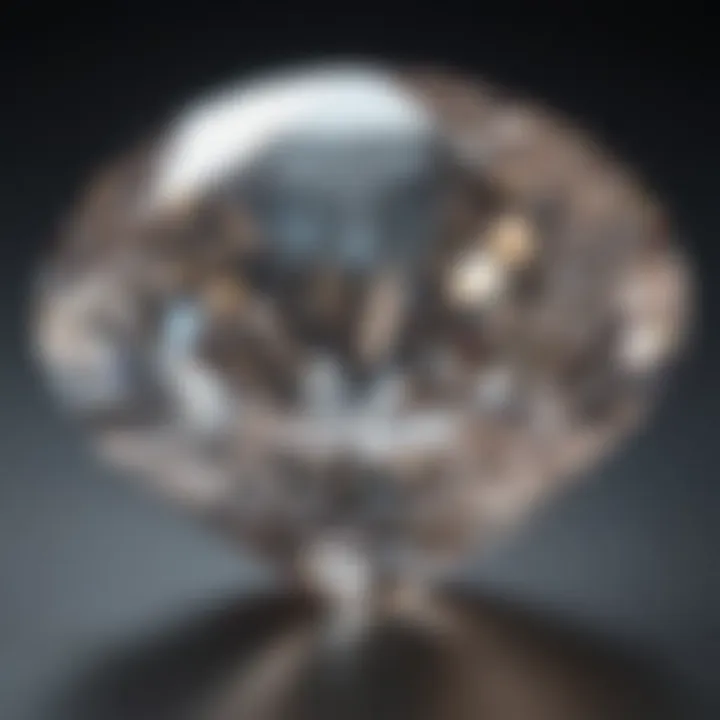
Intro
In the vast landscape of gemstones, diamonds reign supreme, capturing the hearts of many and serving as timeless symbols of love and luxury. But within the shimmering world of these beautiful stones, clarity holds a pivotal role. The clarity of a diamond can immensely influence its overall value and its appeal to buyers.
The clarity scale, established by the Gemological Institute of America (GIA), categorizes diamonds into several grades, ranging from Flawless to Included. Among these categories, the I2 grade often receives mixed reviews, due to its distinct characteristics and the perceptions surrounding it. This article aims to shed light on the I2 grade, elucidating what it truly means for diamond enthusiasts and potential buyers alike.
Gemstone Overview
Definition and characteristics
Diamonds, comprised primarily of carbon atoms arranged in a crystal structure, exhibit remarkable hardness and brilliance. They form under extreme pressure and temperature within the Earth's mantle over millions of years. What sets diamonds apart from other gemstones is their unique optical qualities, which are a consequence of their crystal structure and purity.
Within the realm of gemstones, diamonds are classified based on several key attributes, including color, cut, clarity, and carat weight. Clarity, which refers to the presence of internal or external flaws—known as inclusions and blemishes—plays a critical role in determining a diamond's visual appeal.
Classification of gemstones
There are various classifications of gemstones in the market, but diamonds fall under the category of precious stones. They are generally deemed more valuable than semi-precious stones like garnet or topaz.
- Precious Stones:
- Semi-Precious Stones:
- Diamonds
- Emeralds
- Rubies
- Sapphires
- Amethyst
- Aquamarine
- Opal
- Peridot
In this context, it helps to think of I2 diamonds as part of the broader landscape of clarity grades. They may not hold the glimmering status of higher clarity grades like VS1 or VS2 but have their own place in the market.
Properties of Gemstones
Physical properties
Diamonds are most celebrated for their physical properties. They boast an exceptional hardness, rated a perfect ten on the Mohs scale. This hardness means they can only be scratched by other diamonds, which is one reason they are often set in jewelry destined to last a lifetime.
Furthermore, diamonds possess high refractive indexes, allowing them to bend light in dazzling ways. The result is that even those of lower clarity can sparkle when cut well.
Chemical properties
Chemically speaking, diamonds consist of carbon atoms that are bonded in a tetrahedral lattice structure. This unique bonding grants them their remarkable hardness and thermal conductivity. That's right, diamonds can actually conduct heat better than many metals!
However, it's essential to note that the presence of inclusions can affect a diamond's chemical properties subtly. For example, certain inclusions may contain minerals that alter a diamond's overall appearance or even affect its durability in rare instances.
"A diamond's clarity is the silent architect of its beauty, shaping not only the light that dances within but also the price that buyers are willing to pay."
In summary, I2 diamonds hold a specific place within the diamond clarity scale, marked by distinct characteristics that can make them appealing or unappealing depending on the buyer's perspective. Understanding clarity is not just about assessing flaws; it's about recognizing the intricate balance of beauty and value in these precious stones.
Preamble to the Diamond Clarity Scale
Understanding the diamond clarity scale is crucial for anyone involved in the gemstone industry, whether as a collector, jeweler, or simply an enthusiast. The clarity scale serves as a benchmark, delineating the various levels of transparency and imperfections that diamonds can exhibit. When purchasing a diamond, clarity is often one of the first aspects assessed. It heavily influences not just the jewel's beauty but also its market value. With diamonds, it's not just about the size or the color; clarity can make a world of difference.
Knowing how the clarity grading system works makes the selection process smoother and more informed. For instance, diamonds graded as I2 may not have the same sparkle as their higher-graded counterparts but are often more accessible pricewise. This delicate balance between aesthetics and economics is something that an informed buyer must navigate.
Origins of the Clarity Scale
The clarity scale, as we know it today, traces back to the mid-20th century when gemologists sought a standardized method for evaluating the quality of diamonds. Prior to this, gemstone evaluations varied widely, often relying on subjective assessments. The creation of the clarity scale represented a shift towards a more scientific approach. Initially, the Gemological Institute of America (GIA) introduced the scale, with grades ranging from Flawless (no inclusions visible under 10x magnification) to Included, which covers both I1 and I2 grades.
This structured classification allowed consumers and retailers alike to understand better the complexities involved in diamond grading. Inclusions and blemishes became not just footnotes in a diamond's story, but central characters that dictated the narrative of value and desirability.
Importance of Clarity in Gem Valuation
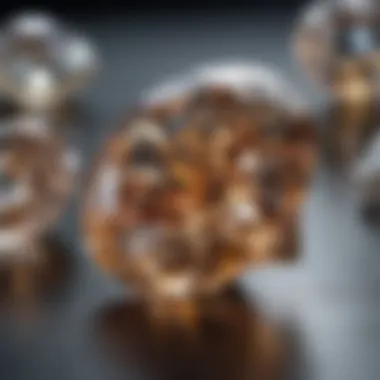
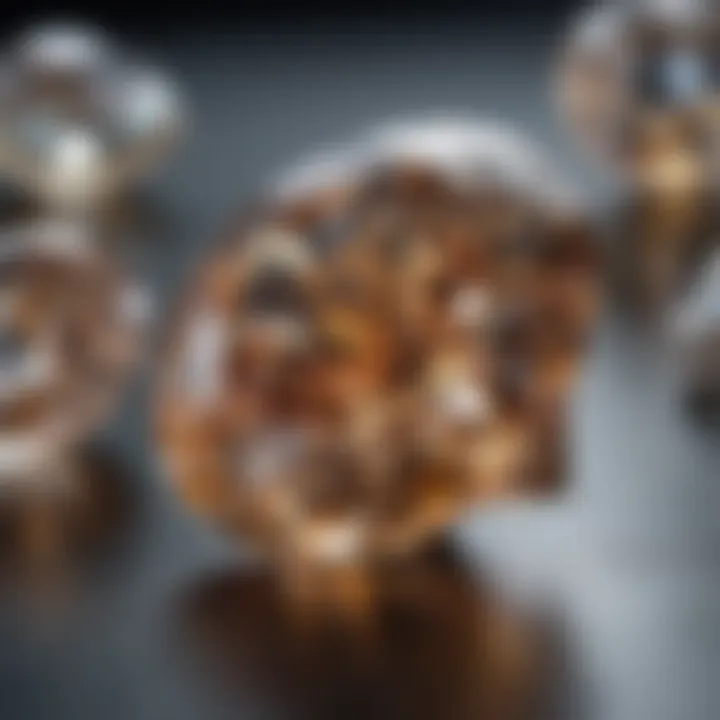
Clarity is a pivotal factor in the valuation of diamonds, impacting both the visual experience and the price tag. As diamonds can exhibit various types of inclusions—ranging from feathers and crystals to clouds—these imperfections can significantly alter how light interacts with the stone.
Consider the following:
- Visual Aesthetics: Higher clarity typically means fewer inclusions, leading to greater brilliance and light performance. However, I2 diamonds, while having visible inclusions, can still be charming in their own right, offering a unique character that some buyers prefer.
- Market Price: Generally, as clarity increases, so will the price. I2 diamonds can appeal to budget-conscious consumers who desire the look of a diamond without breaking the bank.
- Gemological Significance: Understanding clarity helps to assess the longevity of a diamond’s beauty. Inclusions can sometimes pose risks for durability, affecting the stone’s lifespan.
"A diamond’s beauty is often said to lie in its flaws, giving the stone a life story to tell."
Thus, clarity is not just a grading system; it encapsulates the essence of what makes each diamond unique.
Understanding the I2 Grade
When it comes to diamonds, clarity is a vital aspect that significantly influences their overall quality and value. Grasping the nuances of the I2 grade, which sits lower on the clarity spectrum, is essential for both seasoned gem enthusiasts and newcomers alike. The I2 clarity designation signals certain imperfections within the diamond, but it is equally important to decipher how these flaws impact the stone's beauty and market value.
Defining I2 Clarity
In the diamond grading system, I2 clarity diamonds are classified as having noticeable inclusions. These inclusions are flaws found within or on the surface of a diamond. To break it down:
- Inclusions: Commonly known as internal flaws, they can take on various forms, such as tiny crystals, clouds, or even air bubbles trapped inside the diamond.
- Visibility: In I2 clarity diamonds, inclusions are often visible to the naked eye, as they tend to obstruct the gem’s brilliance.
- Implications: Since these imperfections can significantly impact how light interacts with the stone, they might diminish its overall appeal.
The I2 clarity grade illustrates the spectrum of inclusions that can exist. A diamond graded I2 should not be dismissed; it may cater to specific buyer segments looking for budget-friendly options without sacrificing too much on aesthetic appeal.
Visual Characteristics of I2 Diamonds
Visual inspection of I2 diamonds reveals much about their inherent qualities. The presence of noticeable inclusions can alter a diamond's appearance. Here are a few key points worth considering:
- Eye-Catching Inclusions: I2 diamonds typically showcase inclusions that can detract from their sparkle, often creating a cloudy or less radiant appearance.
- How Light Plays: While I2 diamonds may still reflect light, their performance is generally less striking compared to higher clarity grades. The inclusions can serve as barriers to the light paths, which reduces brilliance and fire.
- Unique Patterns: Every I2 diamond is distinct, with individual inclusion patterns that tell a unique story. This aspect can be appealing to some collectors and jewelry designers who value uniqueness over perfection.
Ultimately, while I2 clarity diamonds may not shine as brightly as their higher-graded counterparts, understanding their visual characteristics ensures that potential buyers appreciate their potential and individuality.
"The beauty of a diamond doesn't always lie in its flawlessness; often, it's the imperfections that tell the most compelling stories."
Considering the factors outlined here, individuals can make an informed decision when purchasing an I2 clarity diamond, finding a balance between budget and aesthetic appeal.
Comparative Analysis of Clarity Grades
Understanding the nuances between different clarity grades is crucial for both gem enthusiasts and prospective buyers. It lays the groundwork for appreciating diamonds not merely as shining stones but as intricate natural wonders. The clarity grading system allows one to differentiate diamonds based on the visibility of their internal or external characteristics, known as inclusions and blemishes. This comparative analysis isn’t just an academic exercise; it helps inform budgeting, aesthetic choices, and investment decisions. Knowing how I2 measures up against other grades enables consumers to make choices that reflect their personal values and styling preferences.
I1 vs. I2: Key Differences
When assessing diamond clarity, the distinction between I1 and I2 grades can be pivotal.
- Visibility of Inclusions: Diamonds graded as I1 possess inclusions that are visible under a 10x magnification, yet they might not always be noticeable to the naked eye. In contrast, I2 diamonds display inclusions that are distinctly visible without intimate examination, often affecting the overall appearance.
- Impact on Aesthetics: While an I1 diamond may still maintain a degree of brilliance and clarity, an I2 diamond will typically reflect a more subdued sparkle. This difference arises from how the inclusions disrupt the light passing through the stone. The shadows cast by these inclusions can dull the radiance one expects from a diamond.
- Market Value: Financially speaking, the value of an I1 diamond often sits higher than that of an I2. Buyers are typically willing to pay a premium for better clarity, as it is perceived as a mark of superior quality and beauty.
Thus, when weighing the pros and cons of I1 and I2 clarity, one must consider their own standards for visible defects and overall appeal.
How I2 Compares to Higher Grades
I2 clarity does not inhabit the highest echelons of the clarity scale, particularly when placed side-by-side with grades such as VS1, VS2, or VVS1. The following highlights explain how I2 stacks up against these higher clarity grades:
- Availability: Higher-grade diamonds are rarer to find than I2 diamonds. This scarcity can drive up market value significantly.
- Qualitative Assessment: Higher clarity diamonds often throw a more brilliant sparkle due to fewer inclusions and blemishes that would otherwise interfere with light. This results in a more vibrant gemstone that appeals to many consumers.
- Investment Aspect: While I2 diamonds can be economical choices for those entering the luxury market, they usually don’t hold their value as robustly as higher grades. Investors should think critically about the long-term prospects of resale before committing.
In summary, while I2 diamonds may shine within a certain price range, their appeal diminishes compared to those at higher clarity levels. A keen understanding of these distinctions enriches the buying experience, allowing consumers to align their purchases with their values and preferences.
Inclusions and Their Impact
In the realm of diamonds, inclusions play a pivotal role, particularly when it comes to understanding the I2 grade. Inclusions, which are internal flaws or impurities present within the diamond, have a direct influence on the stone's clarity, appearance, and, ultimately, its value. For those looking to purchase diamonds, especially in the I2 range, grasping the concept of inclusions becomes not just a technical necessity, but a critical part of appreciating the gem’s true beauty.
Understanding inclusions is key. They can affect how light interacts with a diamond, shifting its perceived brilliance and sparkle. Distinguishing between various types of inclusions is equally essential as they differ in their nature and effect.
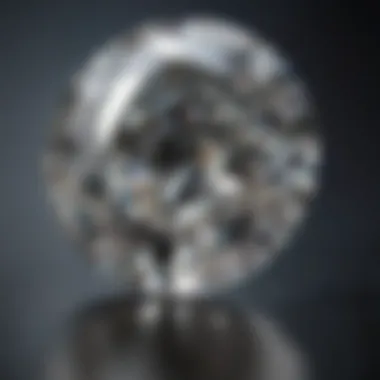
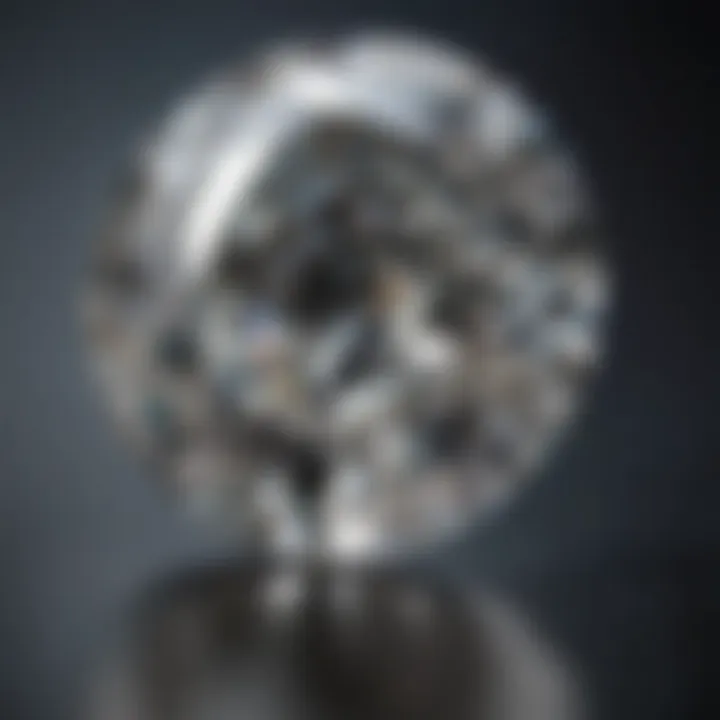
Types of Inclusions Found in I2 Diamonds
The I2 clarity grade includes a variety of inclusions. Most commonly, these might include:
- Feathers: These are small cracks or breaks within the diamond, resembling feathers. Though they can sometimes be difficult to see, they can impact the diamond's durability if they are extensive.
- Blemishes: These are external flaws on the diamond surface. In an I2 grade, blemishes can be significant enough to be seen without magnification.
- Black Spots: Caused by small mineral deposits, black spots can sometimes be stark against the diamond’s surface and are usually eye-visible, making them quite noticeable.
- Clouds: This type of inclusion appears as a misty or cloudy area within the diamond. It can dull the overall sparkle and brilliance.
Each of these inclusions brings its own character to an I2 diamond. Not only do they make the gem unique, but they also tell a story of the diamond's journey through formation.
Influence of Inclusions on Diamond Appearance
The impact of inclusions on a diamond's visual appeal cannot be understated. For I2 diamonds, inclusions often result in a more muted sparkle compared with higher clarity grades. Here are a few vital ways inclusions affect appearance:
- Light Interaction: Inclusions can scatter light differently, leading to potential loss of brilliance. When inclusions interrupt the path of light, it can make the diamond appear less vibrant.
- Visual Weight: An I2 diamond might seem smaller or less captivating than those with higher grades. When viewed from the top, inclusions can detract from the overall impression, even if the diamond is large.
- Personal Charm: Many collectors and enthusiasts argue that inclusions impart a unique personality to diamonds. They may appreciate the distinctiveness and history reflected through the inclusions, turning perceived flaws into personal narratives.
In summary, while inclusions in I2 diamonds bring challenges, they also serve to enrich the stone’s narrative. For buyers, understanding these impacts allows for a more informed decision-making process, enabling them to see beauty beyond the blemishes.
"Every inclusion tells a story, and sometimes the beauty is in the flaws."
As diamond enthusiasts navigate the complexities of the I2 grade, being aware of the composition and influence of inclusions, alongside with their implications on both aesthetics and value, becomes a cornerstone of discerning diamond selection.
Market Perception of I2 Diamonds
The market perception of I2 diamonds is a crucial aspect that influences both their desirability and valuation. While I2 clarity diamonds are often viewed as less desirable compared to higher-grade stones, their unique appeal shouldn't be brushed aside. Understanding how consumers perceive these diamonds can help us appreciate their place in the jewelry market and how buyers can make informed decisions.
Consumer Awareness and Trends
In today’s age of information, consumer awareness plays a vital role in shaping trends. Most diamond buyers tend to gravitate towards higher clarity grades, usually associating them with superior quality. However, there is a noticeable shift as more individuals develop an appreciation for inclusions, recognizing that they can tell a story or add character to a gem.
This sentiment is particularly strong among younger purchasers who prioritize authenticity over status symbols. Consequently, I2 diamonds are increasingly being marketed not just as affordable alternatives, but as unique pieces that challenge the odds. This new perspective is reshaping consumer attitudes, allowing more people to appreciate the distinctiveness of I2 stones, perhaps due to their lower price point combined with an increasing emphasis on individual style over traditional standards of luxury.
Pricing and Valuation of I2 Clarity Diamonds
When it comes to pricing, I2 clarity diamonds often sit at the lower end of the spectrum. The valuation typically hinges on various factors, including clarity, size, and cut. But with I2 diamonds, clarity becomes a defining variable, often leading to misunderstandings about their overall worth.
The pricing for I2 diamonds can vary significantly, influenced by:
- Inclusion visibility: The higher the visibility and quantity of inclusions, the lower the price point.
- Market trends: As mentioned earlier, the rising trend of unique gems might push prices upwards as demand increases.
- Rarity of specific characteristics: Some I2 diamonds possess unique features that might appeal to collectors or those looking for standout pieces.
In summary, while I2 diamonds may often be regarded as less valuable in traditional terms, their market position is evolving. As consumer preferences shift, the willingness to embrace these stones for their individuality rather than just their clarity may lead to a more favorable perception in the future.
"The diamond does not come out of the mine; it is made of the flaws that give it character."
By keeping an eye on changing consumer awareness and the fluid nature of diamond pricing, buyers can navigate the market with a clearer understanding of what I2 clarity diamonds truly represent.
The Buying Process for I2 Diamonds
When it comes to purchasing an I2 diamond, understanding the buying proces is not just advisable; it’s essential. I2 diamonds, while beautiful, come with their unique characteristics that necessitate careful thought and consideration. Whether you are a seasoned collector or a first-time buyer, grasping what to look for can significantly impact your final decision. This section sheds light on what to keep in mind during the buying journey.
Essential Considerations Before Purchase
Before diving into the diamond market, there are several critical factors to weigh:
- Budget Understanding: Establish a realistic budget. I2 diamonds can be more affordable compared to higher clarity grades, but prices still vary widely based on size, color, and overall craftsmanship.
- Purpose of Purchase: Determine the purpose for the diamond. Is it to mark a milestone occasion, or are you adding to a collection? Knowing the intent can steer your choices.
- Inclusion Awareness: Familiarize yourself with the types of inclusions common to I2 diamonds. They can significantly influence appearance and valuation. Being educated on this can help set proper expectations.
- Source of Purchase: Choose a reputable seller. Whether you opt for a local jeweler or an online marketplace, conducting research about the dealer’s background can save you headaches later.
Taking the time to sort through these considerations can make a considerable difference in satisfaction and overall experience.
How to Evaluate Quality in I2 Clarity Diamonds
Evaluating the quality of I2 clarity diamonds can seem daunting. However, with a structured approach, you can effectively assess these stones:
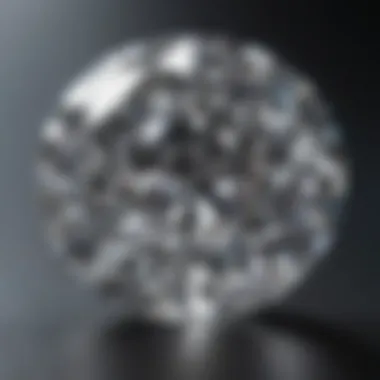
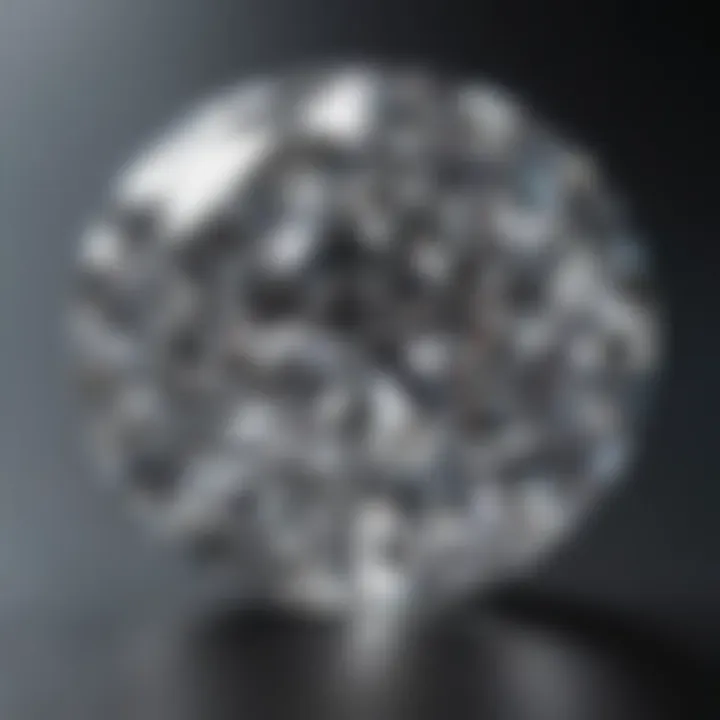
- Gemological Certification: Always insist on certification from a recognized laboratory, such as the Gemological Institute of America (GIA) or the American Gem Society (AGS). This document clarifies the diamond's characteristics, confirming its clarity grade and authenticity.
- Visual Inspection: If possible, examine the diamond in person. Look for inclusions and how they impact the stone’s brilliance. Under magnification, you might see that some inclusions are less noticeable than previously thought.
- Light Performance: Consider how the diamond reflects light. An I2 diamond should still catch the eye if cut properly. Assess its sparkle, fire, and brilliance; even a lower clarity stone can have a lovely play of light.
- Comparative Analysis: Compare the I2 diamond to a similar I1 or I3 diamond. This contrast can help you discern the differences in visual appeal and value, which is particularly important in illustrating the characteristics unique to I2 stones.
Remember: The quality of an I2 diamond might not be as pristine, but that doesn’t mean it cannot hold significant beauty and charm. Each diamond is unique in its way.
Caring for I2 Diamonds
Caring for I2 diamonds is a crucial aspect that often gets overlooked, yet it plays a significant role in maintaining their aesthetic and structural integrity. In the world of gemstones, clarity pertains not only to the visible quality of the diamond but also its overall lifespan and brilliance. For diamond enthusiasts, collectors, and jewelry designers, understanding how to properly care for I2 diamonds can enhance their beauty and ensure they last a lifetime.
Cleaning Techniques for Optimal Brilliance
Keeping I2 diamonds clean is vital for displaying their natural sparkle. Regular cleaning helps to prevent dirt and grime build-up that can dull their charm. Here are some effective techniques:
- Gentle Soap Solution: Mix a few drops of mild dish soap with warm water. Soak the diamond in this solution for 15-20 minutes. Use a soft-bristle toothbrush to gently scrub around the settings and under the diamond. This can help dislodge any stubborn dirt.
- Ultrasonic Cleaners: Be cautious with these devices, as they can be too harsh for some I2 diamonds. It’s better to consult a professional jeweler about using an ultrasonic cleaner, especially if you are unsure.
- Drying: Avoid using paper towels or rough fabrics which can scratch the surface. Instead, use a lint-free cloth to dry the diamond gently. This will help in polishing the surface while preventing any scratches.
"Investing a little time and effort in cleaning can yield brilliance that captures the eye, making your I2 diamond a true showstopper."
Maintaining the Integrity of Inclusions
Preserving the unique inclusions of I2 diamonds adds character and can even enhance their beauty. Unlike higher-grade diamonds, which are evaluated for their lack of inclusion, I2 diamonds are valued for their distinct formations.
- Understand Your Inclusions: Different inclusions tell different stories. Familiarize yourself with what your diamond has. Observing them can help you appreciate their uniqueness more deeply.
- Avoid Hard Impacts: I2 diamonds, with their visible inclusions, may be more susceptible to damage than higher-grade stones. Use caution while wearing them, especially during activities that could lead to hard impacts or scratches.
- Store Separately: When not in use, keep your I2 diamond in a soft pouch or a separate compartment in your jewelry box. This will prevent it from knocking against harder stones and being scratched.
By following these guidelines, you can ensure that your I2 diamond retains its beauty and charm. Care not only preserves the integrity of the stone but also enriches your emotional connection to it. Whether you’re using it in a stunning piece of jewelry or as part of your collection, proper care enhances its inherent value.
Misconceptions About I2 Diamonds
When discussing diamonds, clarity is a vital factor, and the I2 grade specifically tends to attract various misconceptions. This section aims to clarify common misunderstandings surrounding I2 diamonds, allowing potential buyers to make informed decisions. By debunking myths and highlighting the nuances of these gems, we can foster a deeper appreciation for their beauty and uniqueness.
Common Myths Dispelled
There are numerous myths regarding I2 diamonds that can mislead an unwary buyer. Let’s take a closer look at some of the most prevalent ones:
- Inclusions Render I2 Diamonds Unsellable: Many believe that the presence of inclusions automatically devalues an I2 diamond to the point of being unsellable. However, while inclusions do impact the aesthetic quality, they also add character and uniqueness to each stone. These diamonds can appeal to buyers who prioritize individuality over perfection.
- All I2 Diamonds Look the Same: Another common misconception is that all I2 diamonds share a similar appearance. This is far from true. The visibility and type of inclusions can vary significantly from one diamond to another, meaning each stone can present a unique profile depending on its specific characteristics.
- I2 Diamonds Are Low Quality: Some enthusiasts might dismiss I2 diamonds as low quality simply because they sit at the lower end of the clarity scale. Yet, beauty is subjective, and many prefer the raw, natural look of an I2 diamond over the often sterile appearance of higher-graded stones. It’s essential to recognize that quality encompasses more than just clarity.
"Not every diamond needs to be flawless to be valued; often, the story told through its inclusions is what makes it relatable."
- Professional Appraisers Won't Accept I2 Diamonds: Another false belief is that professional appraisers shy away from I2 diamonds. In reality, appraisers consider various attributes, and an I2 diamond can be appraised just like any other stone. Many find unique charm and potential value in I2 diamonds that can be overlooked.
Understanding Value Beyond Clarity
While clarity serves as a pivotal factor in a diamond’s valuation, it is not the sole consideration. The emotional connection, craftsmanship, and even personal preferences contribute significantly to a diamond's worth. Here's what to keep in mind:
- Sentimental Value: A diamond often carries more than monetary worth. It can symbolize love, commitment, or significant milestones. An I2 diamond, whether it has inclusions or not, can still resonate deeply with its wearer.
- Craftsmanship Matters: How a diamond is cut and set can greatly influence its overall aesthetic. An expertly crafted I2 diamond can shimmer and shine beautifully, defying its clarity grade. The setting may also enhance the diamond's natural beauty, making the inclusions less noticeable.
- Trends and Preferences: The jewelry market is always in flux. Currently, there's a growing trend among consumers who appreciate the uniqueness found in lower-clarity diamonds. These buyers are often looking for stones that stand apart from the crowd, making I2 diamonds an attractive option.
- Resale Potential: While I2 diamonds are seen as less desirable in certain circles, they often come with a more accessible price tag. This can make them appealing both for first-time buyers and those looking to expand their collection without breaking the bank.
In summary, dispelling common myths about I2 diamonds is crucial for anyone considering a purchase. Beyond their clarity grade lies a wealth of value and beauty that can enhance the ownership experience. Understanding these nuances fosters appreciation and encourages informed choices.
Closure
In this final chapter, we’ll wrap up the critical discussions surrounding the I2 diamond grade, laying bare the essence of its characteristics and the intrinsic values it brings to the table.
Recap of I2 Diamond Characteristics
I2 clarity diamonds are often painted with a brush of misunderstanding, sometimes unfairly labeled as lesser diamonds. These gems possess visible inclusions that can affect light performance, but they still radiate beauty in their own unique ways. Here are the key points to remember:
- Inclusions: I2 diamonds typically feature inclusions that are easily visible to the naked eye. This can include feathers, clouds, or crystals that may intrude on the gem's pure allure.
- Market Presence: They hold a significant place in the market, appealing to budget-conscious buyers or those seeking a distinctive look without breaking the bank.
- Appearance: While I2 diamonds might not have the sparkle of higher grades, many find their character appealing. Their imperfections can add a story, capturing the beholder's interest in ways that flawless stones might not.
- Affordability: Compared to higher clarity diamonds, I2 stones often present a compelling value proposition. They offer genuine beauty at a more accessible price point.
"A diamond's beauty comes not only from its clarity but also from its ability to resonate with the wearer's story."
Understanding these traits helps in seeing I2 diamonds through a more refined lens. They are not mere placeholders in the clarity scale; they are gems that hold vibrance and invitation to those who choose to embrace their complexities.
Final Thoughts on Purchasing I2 Clarity Diamonds
When venturing into the realm of I2 clarity diamonds, there are several facets to consider:
- Personal Preference: Your choice should resonate with your personal style. If you appreciate character and uniqueness, an I2 diamond might be a perfect match.
- Purpose and Occasion: Think about the context in which the diamond will be used. An engagement ring, for example, invites different expectations than a fashion piece.
- Reappraisal of Value: It’s crucial to remember that the perceived value of a diamond often transcends its grade. While an I2 diamond might not carry the same weight in clarity as higher grades, it can still represent deep value as a token of love and memory.
- Research and Guidance: Always engage with reputable dealers and seek certification to ensure you’re making an informed choice. Various certificates provide insight into the diamond’s characteristics, helping you feel more secure in your decision.



